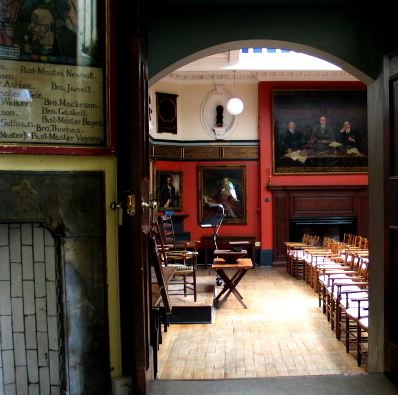
When I got to Zamora I found out that they are celebrating a Feria. Ferias happen all over Spain because every village, town and city has a patron, or Saint watching over everyone. So, once a year you have to give thanks and celebrate!
I arrived on Wednesday evening and the party would start at noon the next day, so I had one morning to find and interview a craftsman. I headed for the Tourist Information Office and explained what I was after. There was a guy there who was just visiting the office, he turned out to work for the local government and also happened to be a sculptor. He offered to introduce me to a couple of people and then proceeded to give me a guided tour of the town. Zamora turns out to have over 20 Romanesque churches and it is also the place where El Cid came from.
The Parador I was staying at was an amazing building; sometimes they are one of the most important buildings in the area and worth a visit even if you are not staying in them.
The following morning I headed to a woodcarving workshop run by Jose Perez and his father. Jose is only 36, he finished a 5-year course in Salamanca and was teaching others by the time he was 20. He learnt the trade from his father and between them do all the large commissions in the area. With so many religious institutions around, 90% of their work is either restoring or making wooden floats that are carried around the village at Easter times. These things are enormous! In Zamora there is a museum dedicated to them.
Sadly Jose was handing out end of term grades that morning, so I spoke to his father, who also had a pair of students in the workshop doing an internship. Here you can see him cutting out a design and on the right you can see some panels Jose has carved for a door. They also, from time to time, make pieces of furniture or mirrors for clients, but they have enough work for the next three years!


I was impressed with the quality, but it was obvious that this workshop is healthy and busy because of the unique circumstances it finds itself in. I did ask if they had been involved in the restoration of an important crib in a nearby village and Miguel said no, some restorers from Madrid had be involved with that project.
The course Jose took in Salamanca has now been shortened to 3 years.
Another craft in Zamora, which I have not seen anywhere else is papier mache dolls. Apparently a couple make them and since leaving Zamora I have also seen them in Leon, so they must be doing well, but I find them a bit creepy. I took this image of them in a store and they have an 'retro' feel about them, that is perhaps appealing to people.

Instead I went to the Museum of Ethnology - which I highly recommend. It is only 4 years old and sponsored by 'Caja de Espana', a large Spanish bank. There are three floor and each

concentrates on a theme. The top floor was all about clay, used in buildings and pottery. The second was all about traditional customs and the first was about home life and artifacts. On my visit the museum also had an exhibition of sculpture by a modern artist. His pieces where displayed among the permanent collection and where directly linked with the permanent collection. It was the first time they had done this and I intend to speak to the Director to ask him how it has been received.
I said good buy to Zamora and made another detour for a tiny village west of where I was meant to be heading. The lady at the tourist information office told me that the traditional costumes of this region of Extremadura where made in 'Calbajares de Alba'. When I got there I thought there was no way there could be a workshop of any kind in this dusty village in the middle of nowhere! I asked the attendant at the petrol station and was told that that did not exist anymore, but just as I was about to get into my car, she said 'wait lets ask the village idiot' - I swear that is what she said! Anyway, this poor individual was walking along the other side of the road and came over when called, she said yes there where still some ladies working at the workshop, so I went looking for them. I found them; Maria Jesus and Mercedes, and boy was I in for a treat!


The work is so labour intensive that it takes 5 women 5 months to produce a skirt. It is a one-off and will cost about 1,300 euros. These skirts are used on special occasions and handed down in the family. The building was build in the 60s to support the future of this craft. However, there are only 5 ladies left and they are all retired, three of them currently not working because of family responsibilities or ill health. They can´t see a future and have no one to teach. I think the location is a big factor, but I came away passionately wanting to save this craft if I can.
You can learn more about the town on the following website - all in Spanish of course...
Calbajares de Alba (Zamora) www.geocities.com/TheTropics/Cabana/6344/PRINCIPAL.HTM
you have to look up "Traje Carbajalino" on the left hand side.


I have not put the best pictures in - you will have to come to the exhibition of photographs I will put up at the Guild when I return.
Like the bullfighting costumes, the skills needed to keep this traditions alive, have to be used in a modern context or they will disappear, and when you think that rich people are quite willing to spend 3 to 5 thousand pounds on a mass produced handbag or watch, you have to wonder where the logic lies?...
Apart from the influence of marketing, of course.
It doesn't help that I was told by Maria Jesus that she did not want me to photograph some of the pieces and that she did not want more work, she was too old to teach and just saw it as a hobby. Mercedes, who is more active and sees the importance of what they are doing, explained that unless there was a regular income for the 5 ladies, you could not expect them to continue or show interest in passing their skills on. You can´t make a living out of it.

I said good buy with the sun going down and leaving a trail of red dust on the road.
Extremadura is so rich in crafts and manual skills, but feels like the third world, maybe that is why they still exist? I wonder how the recession will effect them, so far I have seen little evidence.
 One of the reasons I wanted to come here was because I would coincide with a craft fair. It was a good opportunity to meet several makers at once from different areas of the region. There is a real mixture of standards and traditional crafts sit uncomfortably next to contemporary ones, with very little fusion between the two. A large percent of makers are what I would describe as hippies of the 80s - I don't mean this in a derogative way. In a lot of cases, it is thanks to them that some of these crafts are surviving.
One of the reasons I wanted to come here was because I would coincide with a craft fair. It was a good opportunity to meet several makers at once from different areas of the region. There is a real mixture of standards and traditional crafts sit uncomfortably next to contemporary ones, with very little fusion between the two. A large percent of makers are what I would describe as hippies of the 80s - I don't mean this in a derogative way. In a lot of cases, it is thanks to them that some of these crafts are surviving. I left early the next day excited to head in to the mountains and, I was rewarded with some great views. On the way down to the coast I had to take some nail-biting bends ... and it began to rain very hard and then there was hail... all quite exciting.
I left early the next day excited to head in to the mountains and, I was rewarded with some great views. On the way down to the coast I had to take some nail-biting bends ... and it began to rain very hard and then there was hail... all quite exciting. This is a Spain I do not know and I was looking forward to arriving at Santillana del Mar, where I was going to stay for two nights. The buildings are made of a soft yellow stone and there are wooden verandas. I arrived at another feria!!
This is a Spain I do not know and I was looking forward to arriving at Santillana del Mar, where I was going to stay for two nights. The buildings are made of a soft yellow stone and there are wooden verandas. I arrived at another feria!!  The village was full of children and they where being chased by these giants who would run after them beating them with brooms. They where also letting off a lot of firecrackers and everyone was having a great time.
The village was full of children and they where being chased by these giants who would run after them beating them with brooms. They where also letting off a lot of firecrackers and everyone was having a great time.  When that came to an end the music started and the BBQ was ready - free food and beer - all paid be the local council.
When that came to an end the music started and the BBQ was ready - free food and beer - all paid be the local council.

 There where lots of people out enjoying the sunshine and there was a triathlon going on.
There where lots of people out enjoying the sunshine and there was a triathlon going on. Oh, Comillas also has a building designed by Gaudi, it is called 'El Capricho'
Oh, Comillas also has a building designed by Gaudi, it is called 'El Capricho'  and you can enjoy eating there, it is now a posh restaurant. I preferred Comillas to Santillana, it was real, were as the village I was staying at felt like a theme park.
and you can enjoy eating there, it is now a posh restaurant. I preferred Comillas to Santillana, it was real, were as the village I was staying at felt like a theme park.









































